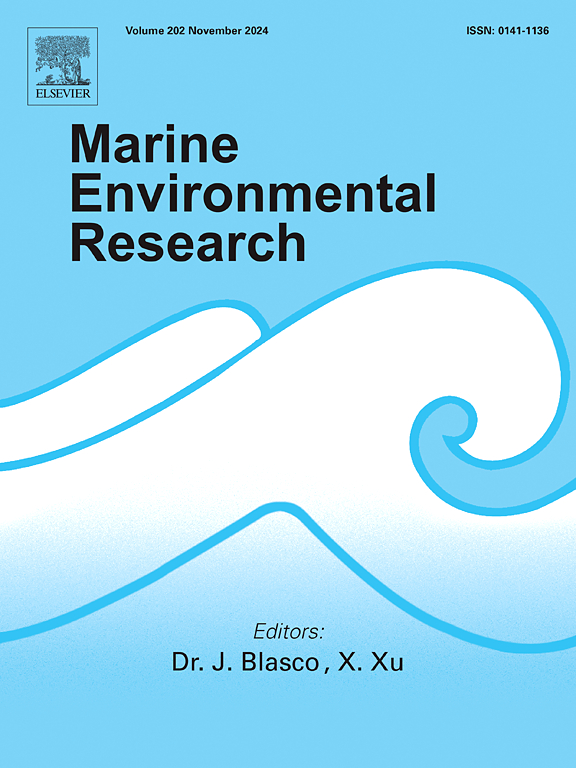培养双鞭毛藻Lingulaulax polydra(原Lingulodinium polydra)的光合作用和光保护动力学
IF 3.2
3区 环境科学与生态学
Q2 ENVIRONMENTAL SCIENCES
引用次数: 0
摘要
研究光合作用和浮游植物的生长对于更好地了解初级生产力,特别是对有害藻华(HABs)的前体,如鞭毛藻Lingulaulax polydra(原Lingulodinium polydra)的初级生产力具有重要意义。研究了低浓度200.3/10.3 μm、中浓度280.5/14.8 μm、高浓度479.7/26.3 μm NaNO3/NaH2PO4和辐照度(50、150、300和750 μmol量子m−2 s−1)对L. polydra体外培养生长速率(μ)、光合效率(α)、相对电子传递率(rETR)、色素浓度和吸收系数的影响。观察到,μ不随营养浓度和辐照度的变化而变化(p > 0.05, AN),培养第9天各处理均处于平稳生长期。随着辐照度的增加,不同处理的光保护性类胡萝卜素显著增加,光合色素显著减少。在50 μmol量子m−2 s−1辐照下,L. polyedra在固定相的α值最高,为0.259±0.005。培养没有显示营养物之间的差异,这表明物种对光可用性的特定反应取决于生长阶段。该研究表明,L. polyedra根据辐照度调整其能量利用,在指数期优先生长,在平稳期优化光合作用以分配养分。这项研究有助于了解该物种在不同辐照度和营养浓度下的适应能力,这有助于了解使其可能形成有害藻华(HABs)的适应性。本文章由计算机程序翻译,如有差异,请以英文原文为准。
Photosynthesis and photoprotection dynamics in cultured dinoflagellate Lingulaulax polyedra (formerly Lingulodinium polyedra)
The study of photosynthesis and the growth of phytoplankton organisms is important for a better understanding of primary productivity, especially in precursors of harmful algal blooms (HABs), such as the dinoflagellate Lingulaulax polyedra (formerly Lingulodinium polyedra). The effect of nutrient availability (low concentration: 200.3/10.3 μM, medium: 280.5/14.8 μM, and high: 479.7/26.3 μM NaNO3/NaH2PO4) and irradiance (50, 150, 300, and 750 μmol quanta m−2 s−1) on the growth rate (μ), photosynthetic efficiency (α), relative electron transport rate (rETR), pigment concentration and absorption coefficient in in vitro cultures of L. polyedra was analyzed. It was observed that μ did not vary with nutrient concentration or irradiance (p > 0.05, AN), and the stationary growth phase was observed in all treatments on day 9 of cultivation. As irradiance increased, significant increase in photoprotective carotenoid pigments and a reduction in photosynthetic pigments were observed among treatments. L. polyedra showed the highest α during the stationary phase in treatments under 50 μmol quanta m−2 s−1 irradiance, with a value of 0.259 ± 0.005. Cultures did not show differences between nutrients, suggesting that the species-specific response to light availability depends on the growth phase. This study suggests L. polyedra adjusts its energy use based on irradiance, prioritizing growth in the exponential phase and optimizing photosynthesis for nutrient distribution in the stationary phase. This study contributes to understanding the species’ resilience at different irradiances and nutrient concentrations, which can help to understand the adaptations that allow it to potentially form harmful algal blooms (HABs).
求助全文
通过发布文献求助,成功后即可免费获取论文全文。
去求助
来源期刊

Marine environmental research
环境科学-毒理学
CiteScore
5.90
自引率
3.00%
发文量
217
审稿时长
46 days
期刊介绍:
Marine Environmental Research publishes original research papers on chemical, physical, and biological interactions in the oceans and coastal waters. The journal serves as a forum for new information on biology, chemistry, and toxicology and syntheses that advance understanding of marine environmental processes.
Submission of multidisciplinary studies is encouraged. Studies that utilize experimental approaches to clarify the roles of anthropogenic and natural causes of changes in marine ecosystems are especially welcome, as are those studies that represent new developments of a theoretical or conceptual aspect of marine science. All papers published in this journal are reviewed by qualified peers prior to acceptance and publication. Examples of topics considered to be appropriate for the journal include, but are not limited to, the following:
– The extent, persistence, and consequences of change and the recovery from such change in natural marine systems
– The biochemical, physiological, and ecological consequences of contaminants to marine organisms and ecosystems
– The biogeochemistry of naturally occurring and anthropogenic substances
– Models that describe and predict the above processes
– Monitoring studies, to the extent that their results provide new information on functional processes
– Methodological papers describing improved quantitative techniques for the marine sciences.
 求助内容:
求助内容: 应助结果提醒方式:
应助结果提醒方式:


